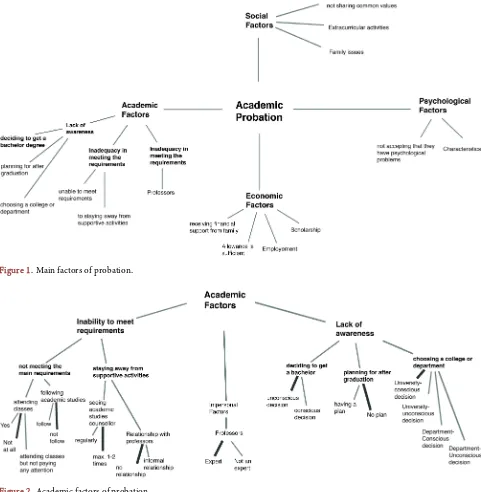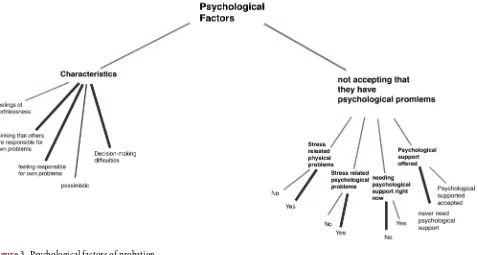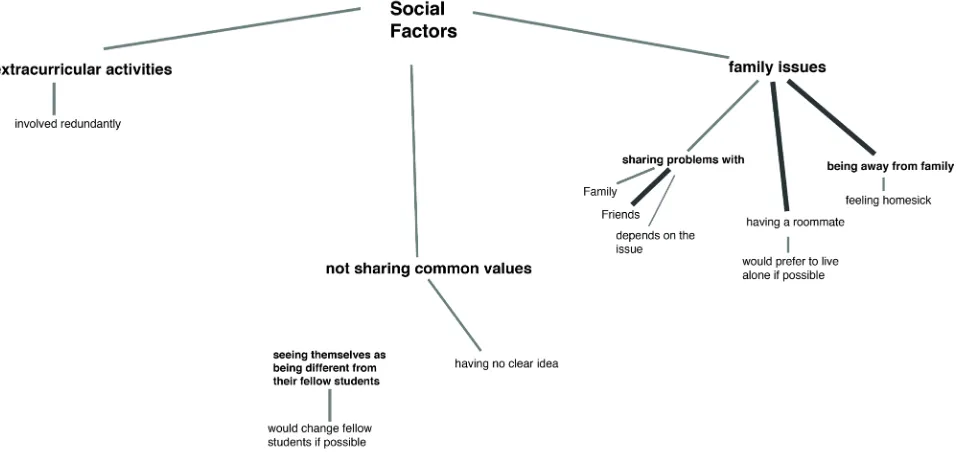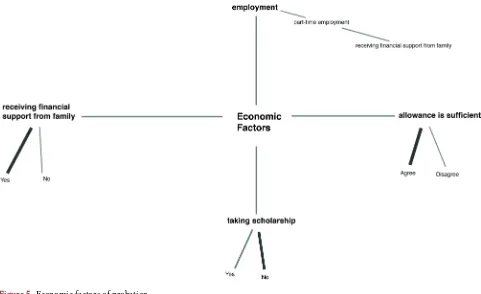ISSN Online: 2152-7199 ISSN Print: 2152-7180
Why Do Students Who Are Eligible to Enter
University Fall into Academic Probation and
What Possibilities Are There for Effective
Interventions?
Salim Atay
1,2, Jean-Jacques Ruppert
3,4,
Neşe Gülmez
1,
Banu Çırakoğlu
2,
Hakan Kılıç
11Istanbul Technical University, Istanbul, Turkey
2Career and Talent Management Association, Istanbul, Turkey
3University of Applied Labour Studies of the Federal Employment Agency (HdBA), Mannheim, Germany 4Applied Vocational Psychology and Policy Research Unit (AVOPP), Esch-sur-Alzette, Luxembourg
Abstract
Probation is the academic status of students who do not meet minimum aca-demic criteria of Grade Point Average (GPA) as specified by the university. Probation furthermore restricts the amount of credits that can be loaded. It is a growing problem with many different causes. It has been studied for many years with e.g. The Student Adaptation to College Questionnaire (SACQ) consists of four subscales that are social adjustment, personal-emotional ad-justment, academic adjustment and institutional attachment (Gerdes & Mal-linckrodt, 1994). In 2014, Istanbul Technical University (ITU) Dean of Stu-dent and Registrar’s Office published the General Statistical Evaluation Report highlighting the issue of academic probation. In this study the authors aimed to identify the reasons of academic probation and to set up an intervention model at the University Career Centre. For this purpose, semi-structured in-terviews and group discussions were conducted with 182 undergraduate aca-demic probation students from 13 faculties. Data analysis using Qualitative Data Analysis Software (MAXQDA) was used to identify the reasons for aca-demic probation. Once the reasons had been identified, existing tools were improved and new tools were developed. After the implementation of various intervention measures such as promoting career summits, setting up a web portal, informing the administration of the university of the importance and necessity of creating open areas, the results were analysed. At the end of a two-year period of strenuous efforts, the effectiveness of those measures was evident as the probation rate had dropped from 23.46% to 17.08% (ITU Dean of Student and Registrar’s Office, 2014, 2016).
How to cite this paper: Atay, S., Ruppert, J.-J., Gülmez, N., Çırakoğlu, B., & Kılıç, H. (2017). Why Do Students Who Are Eligible to Enter University Fall into Academic Pro- bation and What Possibilities Are There for Effective Interventions? Psychology, 8, 1342- 1354.
https://doi.org/10.4236/psych.2017.89087
Received: June 12, 2017 Accepted: July 17, 2017 Published: July 20, 2017
Copyright © 2017 by authors and Scientific Research Publishing Inc. This work is licensed under the Creative Commons Attribution International License (CC BY 4.0).
Keywords
Academic Probation, Career Centre, Counselling
1. Introduction
Academic probation is the academic status of students who do not meet mini-mum academic standards and it is widely used by many universities (Lindo, Sanders, & Oreopoulos, 2010). Students fall into academic probation if their GPA does not meet those requirements. It is a common issue for many HE in-stitutions that has been investigated by various authors who aimed at reaching a greater understanding of the causes of academic failure (Pantages & Creedon, 1978;Astin, 1984; Pritchard & Wilson, 2003).
High school graduates are faced with the necessity of adjustment to a new life as soon as they enter university (Shim & Ryan, 2012) as they must adapt to a new environment and its demands. A sizeable number of students are worried about their ability to cope with the new situation and if they fail to overcome this issue and do not find ways to adjust, they may end up no longer paying any at-tention to their GPA and decide to leave university. Aspelmeier, Love, McGill, Elliott, and Pierce (2012) observed that there is a relationship between college adaptation and GPA and therefore it is important to create environments that facilitate students’ involvement.
Academic adjustment has been investigated most frequently. Baker and Siryk (as cited in Gerdes & Mallinckrodt, 1994) indicated that a well-defined goal, a strong attachment to the institution, and a high motivation to learn are also ele-ments of academic adjustment. Furthermore, psychological variables such as personal or emotional problems, anxiety, and low self-esteem have an influence on academic achievement (Gerdes & Mallinckrodt, 1994; Pritchard & Wilson, 2003).
Boyer and Sedlacek (1988) indicated that social support also predicts GPA. Gray, Vitak, Easton and Ellison (2013) found that a strong sense of integration is an important element for future academic success. Being well integrated into so-cial life at college, having a supportive network and good relationships with staff are important components of social adjustment (Gerdes & Mallinckrodt, 1994). Finally, Astin (1984) argued that holding a part-time on-campus job influences retention in a positive way while off-campus jobs have adverse effects on reten-tion.
time placed on academic probation. This is the reason why the University’s Ca-reer Centre conducted this research to identify those factors that lead to the fail-ure of undergraduates who had performed outstandingly well in the ITU admis-sion exams and, ideally, also to develop effective intervention tools. This study was carried out with undergraduates who had been placed on probation because of their poor academic performance. It is hypothesised that poor adjustment to university life has a negative effect on students, leading into academic probation as students who have difficulties adapting to Higher Education will also get lower grades. It is also anticipated that academic probation might be reduced through specific interventions.
2. Method
2.1. Participants
650 undergraduates on probation were invited for an interview via e-mail. 182 students from 13 faculties volunteered to participate in the study. There were 158 male students and 24 female students with an average age of 21.5. Finally, the average of their GPAs was 1.49.
2.2. Measures & Procedure
We used a semi-structured interview technique. There were one-on-one inter-views as well as group discussions. SACQ constituted the base for our questions. SACQ (as cited in Kurtz, Puher, & Cross, 2012), a 67-item questionnaire, is a self-report measurement tool commonly utilised in studies on college adjust-ment. The questionnaire has four subscales: Academic Adjustment, Social Ad-justment, Personal-Emotional AdAd-justment, and Institutional Attachment. The Academic Adjustment subscale includes 24 items, the Social Adjustment sub-scale includes 20 items, the Personal-Emotional Adjustment subsub-scale includes 15 items, and the Institutional Attachment subscale includes 15 items. The Institu-tional Attachment subscale shares 8 items with the Social Adjustment subscale and 1 item with the Academic Adjustment subscale. Baker and Siryk (as cited in Gerdes & Mallinckrodt, 1994; Martin, Swartz-Kulstad, and Madson (1999)) showed that the internal consistency reliability is quite high for the full SACQ scale, ranging from .89 to .95, with the subscales’ internal consistency reliability ranging from .73 to .91. Several applications of the SACQ have provided correla-tions ranging from .68 to .90 between the subscales and the full scale (Gerdes & Mallinckrodt, 1994). In consideration of these correlations, four basic compo-nents in academic probation i.e. academic, psychological, social and economic factors, were investigated in this study. The interviews were written down and coded. They were then analysed in terms of content analysis through MAXQDA 12, and the results were visualised by showing the associations between the codes.
3. Results
were identified (see Figure 1).
3.1. Academic Factors
Three main issues were identified within academic factors leading to probation (see Figure 2). Lack of awareness was the first academic factor with students de-ciding to go to university without a specific purpose. They entered Higher Edu-cation because e.g. everybody else did so or because it was expected of them. Furthermore, although students who ended up on probation had deliberately opted for the ITU, they had neither chosen their department in a careful manner nor did they have any plans about what to do after graduation, or even see the
[image:4.595.58.539.233.725.2]Figure 1. Main factors of probation.
need for having such a plan. All they did was taking into consideration other in-dividuals’ advice, putting their faith in the hypothetical economic return of a given profession or simply relying on their performance in the university en-trance exam.
A second issue that came to light was these students’ inadequacy in meeting minimal requirements such as attending lectures. To make matters worse, they were at the same time also staying away from supportive activities. Gerdes and Mallinckrodt (1994) indicated that e.g. informal contact with professors was an indicator for not dropping out of students who were struggling academically. Furthermore, probation students did not take up the opportunity to see their academic counsellors or to get in touch with their professors outside of classes. Finally, although 65% of probation students indicated that their academics were on the whole experts in their field, 60% nevertheless thought that these academ-ics were not all that good as lecturers.
3.2. Psychological Factors
Psychological factors play in important part in academic probation. As it can be seen in Figure 3, psychological factors can be divided into two categories: spe-cific characteristics, and an overall refusal to accept having any psychological is-sues. Aspelmeier et al. (2012) showed that certain types of locus of control were associated with GPA. We did however not observe a behavioural trend in locus of control in our study as the number of students on probation who regarded themselves as responsible for their problems was close to the number of students who blamed others for their problems.
[image:5.595.64.542.474.729.2]Decision-making difficulties, pessimism and feelings of worthlessness were specific characteristics of probation students. Although 74% of students stated
that they did not need any psychological support, 87% of them were suffering from stress-related psychological problems and 81% from stress-related physical problems.
3.3. Social Factors
Four specific components emerged among the social factors as given in the an-swers of the students on probation (see Figure 4). They believed that they were not sharing common values with their fellow students. Gerdes and Mallinckrodt (1994) showed that students from socially disadvantaged backgrounds may ex-perience a certain discomfort because of feeling different from other students. In our study, 42% of probation students saw themselves as being different from their fellow students, and 40% would, given the chance to do so, choose other fellow students.
Gray, Vitak, Easton, & Ellison (2013) and Plant, Ericsson, Hill, & Asberg (2005) had pointed out the influence of extracurricular activities pertaining to academic probation. In our study, extracurricular activities and family issues were also found to play a part in academic probation. Thus, a quarter of those probation students who were living away from their families admitted to being homesick. And although 64% of students on probation were living with fellow students, 81% would rather be living on their own if they could afford to do so as they said having issues with their roommates. Nevertheless 58% of probation students in-dicated that they shared their problems with friends.
3.4. Economic Factors
[image:6.595.62.545.492.721.2]Finally, economic factors played an important role in academic probation. Em-ployment, level of allowance, scholarship and financial support from family were taken into consideration (see Figure 5). Of the 87% of students on probation
Figure 5. Economic factors of probation.
who were receiving financial support from their families, a quarter thought this was back-breaking for their families. 84% of probation students were satisfied with the level of their allowance, and 42% were part-time employees. And even though 87% of part-time employees were supported financially by their families, they thought that employment affected their scores negatively. Bodvarsson and Walker (2004) however found that students who received financial help from their families failed more courses than students who did not receive such sup-port. Moreover, the likelihood of them falling into probation was higher than that of students who did not receive such help and their GPA were also lower. Finally, because of their low GPA, probation students were unable to take on a scholarship.
3.5.
Probation Reasons from the Point of View of Probation
Students
Figure 6. Reasons for probation from probation students’ point of view.
course requirements were put forth as reasons for poor academic performance by students on academic probation, the Trendence Graduate Barometer 2015 report on the ITU does not support this observation as the work of the academic staff was found to be a good performance indicator for the ITU.
The ITU Career Centre (ICC) recognised the necessity to motivate students to formulate a plan in order to improve their academic standing. Hence the ICC worked hard to raise the awareness of the university on the issue of academic probation. The ICC also looked into using existing tools in a more efficient way and put great effort into the development of new tools in order to achieve effec-tive results in the prevention of students falling into academic probation.
4. Intervention Tools
4.1. Enhancing Existing Tools
4.1.1. Reorganising the ICC Team
communicating with businesses. Additionally, a psychologist specialised in hu-man resources transferred from the private sector to the ICC as a career con-sultant. This psychologist knows exactly what companies expect from new graduates and helps students to meet those demands. Since the reorganisation of career centre, task management has become more efficient and the effectiveness of the ICC has increased dramatically.
4.1.2. Career Summit and Events
The ITU Career Centre is a bridge between students and business. Every year in the last week of February, it organises the biggest career summit of Eurasia with the aim to facilitate contact between students and employers. Companies ar-range workshops, present case studies, set up interviews and accept job and in-ternship applications. While in the past the ITU Career Summit happened in one place only, it has now been moved to nine different locations on several university campuses, thus giving more students the opportunity to attend the fair and to meet the world of business. In meetings with human resources spe-cialists, students may come to realise that they must increase their GPA, that they must come up with a plan or several plans for life after graduation in order to find employment. Gerdes and Mallinckrodt (1994) found that students who struggle academically, greatly benefit from career planning assistance as it helps them to formulate goals. When organising the ICS, the ICC also involved the student clubs thus providing students with self-improvement opportunities in organising, planning, and communication skills. Moreover, this experience promotes bonding amongst fellow students as they share common interests, purposes and values. The ICS’16 was a huge success with the presence of 137 companies and with close to 30,000 students attending.
4.1.3. Online Services
Marketing of one’s services and gaining recognition for one’s work is crucial to improve one’s efficiency. Here social media play an important part as the ICC has more than 165,000 followers on social media. In addition, the ICC relies on more traditional tools such as information bulletins and banners. Thus, the ICC can reach and inform more people, raise their awareness of its activities and in-form them about new developments.
4.1.4. Career Counselling
Furthermore, the ITU Career Centre has a comprehensive offer in career coun-selling services to ITU students such as writing a job application letter, a CV, familiarising them with interview techniques as well as career counselling proper.
di-rected towards the ITU Psychological Counselling Services.
Those students at the Istanbul Technical University (ITU) who had won a scholarship because of their excellent performance in the university entrance exam, and who later lost it because of their poor academic performance and ended up on probation, were invited to go and see the Office of Scholarships to look for alternatives they could benefit from if their academic standing were to improve.
4.1.5. Other Forms of assistance
Absenteeism was one of the academic factors leading to probation. Students were encouraged to adjust their extracurricular activities to their workload and reminded that attending classes has a greater impact on their performance than self-study (Dolton, Marcenaro, & Navarro, 2003). Attending classes also pro-motes good communication between lecturers and students, and gives students the opportunity to debate course topics with their fellow students. The academ-ics at the ITU also recommend that students should, if possible, not work in their freshman and sophomore years to prevent absenteeism.
Students on probation were incited to go and see their academic advisors to discuss their courses and life at university. Through career counselling, those students who were dissatisfied with their study choice could then be shown various alternatives, ranging from transferring to a different department to opt-ing for different study programmes. If probation was related to havopt-ing made an initial “bad” choice, these alternatives could broaden perspectives for these stu-dents.
4.2.
Creating and Implementing New Tools
4.2.1. Web Portal
In today’s world, a digital presence is a must. Seeing the need for an online plat-form early on, the ICC launched a web portal named the ITU career and Talent management (ITU-KAYS). This portal facilitates communication with students and allows the publication of announcements, internships and job opportunities for ITU students. Furthermore, students can also make an appointment with a career counsellor through ITU-KAYS. To date almost 200 employers and over 8000 students are registered as regular users on ITU-KAYS.
4.2.2. New Career Fair
In 2015 a new event named the National Engineering Career Fair (TUMKAF), was added to the long-established ICS. 66 companies were present with their booths at TUMKAF and 7530 engineering students and graduates from all over Turkey attended.
4.2.3. Setting up of Open Areas
so in the best possible conditions. Finally, with the aim to promote greater so-cialising between students, the rectorate also agreed to the redevelopment of ca-fés and restaurants on ITU grounds.
4.2.4. Other Measures
ITU has a long-established reputation in engineering education in Turkey since 1773. Today it owns 6 technoparks under the name of ARI Teknokent where more than 200 Research & Development projects are carried out, thus providing many openings for ITU students such as internships, project works, and part-time or full-time job opportunities. ARI Teknokent also offers via the ITU Seed start-up and entrepreneur ecosystem financial support to many ITU stu-dents who have creative and innovative ideas. In this regard, beyond an engi-neering education of the highest quality, the ITU ARI Teknokent also presents students with opportunities to realise their own innovative ideas through pro-jects.
One of the reasons why students fall into probation originates in the decisions they make at high school on what and where to study. It is therefore important to highlight the ongoing developments implemented by the ICC on career and talent management. A master degree programme and a certificate programme have been elaborated and a graduate programme will accept applications from prospective students this fall. The certificate programme has been offered twice and attracted considerable attention. Its objective is to provide career counsel-lors with academic qualifications of a high standard. The ICC believes that these counsellors will ultimately be in a very good position to help students to make “better” decisions regarding universities, study fields, and ultimately also occu-pational choices.
5. Conclusion
These efforts brought about great rewards. The rate of academic probation fell from 23.46% to 17.08% (ITU Dean of Student and Registrar’s Office, 2014, 2016). According to the Universum Talent Research (2015), 85% of ITU stu-dents use one or more of the ICC career services on offer to great satisfaction. Furthermore, ITU students show a keener interest in career fairs where they can meet prospective employers than students from other universities. Finally, Trendence (2015) indicates that the ITU career services are amongst the best there are.
To conclude, it is important to emphasise that in our study we took only a single instant photo of academic probation at ITU. What we need to do now is to create a photo album to look at the situation at other universities and to iden-tify possible differences and similarities. Moreover, our sample did not include any students with good academic standing. Their views on probation might offer different perspectives leading to further studies. Such an approach could also lead to the elaboration of a mentorship programme, matching probation stu-dents with academically successful ones.
References
Ahmed, J. U., Chowdhury, M. K., Rahman, S., & Talukder, A. H. (2014). Academic Pro-bation: An Empirical Study of Private University Students. Research in Education, 92,
1-17. https://doi.org/10.7227/RIE.0001
Aspelmeier, J. E., Love, M. M., McGill, L. A., Elliott, A. N., & Pierce, T. W. (2012). Self-Esteem, Locus of Control, College Adjustment, and GPA among First- and Con-tinuing-Generation Students: A Moderator Model of Generational Status. Research in Higher Education, 53, 755-781. https://doi.org/10.1007/s11162-011-9252-1
Astin, A. W. (1984). Student Involvement: A Developmental Theory for Higher Educa-tion. Journal of College Student Personnel, 25, 297-308.
Bodvarsson, Ö. B., & Walker, R. L. (2004). Do Parental Cash Transfers Weaken Per-formance in College? Economics of Education Review, 23, 483-495.
https://doi.org/10.1016/j.econedurev.2003.11.009
Boyer, S. P., & Sedlacek, W. E. (1988). Noncognitive Predictors of Academic Success for International Students: A Longitudinal Study. Journal of College Student Development, 29, 218-223.
Dolton, P., Marcenaro, O. D., & Navarro, L. (2003). The Effective Use of Student Time: A Stochastic Frontier Production Function Case Study. Economics of Education Review, 22, 547-560. https://doi.org/10.1016/S0272-7757(03)00027-X
Dunwoody, P. T., & Frank, M. L. (1995). Why Students Withdraw from Classes. The Journal of Psychology, 129, 553-558. https://doi.org/10.1080/00223980.1995.9914927 Gerdes, H., & Mallinckrodt, B. (1994). Emotional, Social, and Academic Adjustment of
College Students: A Longitudinal Study of Retention. Journal of Counseling and De-velopment, 72, 281-288. https://doi.org/10.1002/j.1556-6676.1994.tb00935.x
Gray, R., Vitak, J., Easton, E. W., & Ellison, N. B. (2013). Examining Social Adjustment to College in the Age of Social Media: Factors Influencing Successful Transitions and Per-sistence. Computers & Education, 67, 193-207.
https://doi.org/10.1016/j.compedu.2013.02.021
Heisserer, D. L., & Parette, P. (2002). Advising at Risk Students in College and University Settings. College Student Journal, 36, 69-83.
ITU (n.d.). From Past to Future.
http://www.itu.edu.tr/en/about-itu/general/general-information
ITU Dean of Student and Registrar’s Office (2014). General Statistical Evaluation Report. ITU Dean of Student and Registrar’s Office (2016). General Statistical Evaluation Report. Kurtz, J. E., Puher, M. A., & Cross, N. A. (2012). Prospective Prediction of College
Ad-justment Using Self- and Informant-Rated Personality Traits. Journal of Personality Assessment, 94, 630-637.https://doi.org/10.1080/00223891.2012.672506
Standards: Evidence from Academic Probation. American Economic Journal: Applied Economics, 2, 95-117.https://doi.org/10.1257/app.2.2.95
Martin, W. E., Swartz-Kulstad, J. L., & Madson, M. (1999). Psychosocial Factors That Predict the College Adjustment of First-Year Undergraduate Students: Implications for College Counselors. Journal of College Counseling, 2, 121-133.
https://doi.org/10.1002/j.2161-1882.1999.tb00150.x
Pantages, T. J., & Creedon, C. F. (1978). Studies of College Attrition: 1950-1975. Review of Educational Research, 48, 49-101.https://doi.org/10.2307/1169909
Plant, E. A., Ericsson, K. A., Hill, L., & Asberg, K. (2005). Why Study Time Does Not Predict Grade Point Average across College Students: Implications of Deliberate Prac-tice for Academic Performance. Contemporary Educational Psychology, 30, 96-116. Pritchard, M. E., & Wilson, G. S. (2003). Using Emotional and Social Factors to Predict
Student Success. Journal of College Student Development, 44, 18-28. https://doi.org/10.1353/csd.2003.0008
QS Top Universities (2015). Istanbul Technical University.
http://www.topuniversities.com/universities/istanbul-technical-university#wur Shim, S. S., & Ryan, A. M. (2012). What Do Students Want Socially When They Arrive at
College? Implications of Social Achievement Goals for Social Behaviors and Adjust-ment during the First Semester of College. Motivation and Emotion, 36, 504-515. https://doi.org/10.1007/s11031-011-9272-3
Smith, C. P., & Winterbottom, M. T. (1970). Personality Characteristics of College Stu-dents on Academic Probation. Journal of Personality, 38, 379-391.
https://doi.org/10.1111/j.1467-6494.1970.tb00016.x
Trendence Institute (2015). Trendence Graduate Barometer 2015.
Universum (2015). Universum Talent Research 2015 Partner Report. Istanbul Technical University (ITU).
Submit or recommend next manuscript to SCIRP and we will provide best service for you:
Accepting pre-submission inquiries through Email, Facebook, LinkedIn, Twitter, etc. A wide selection of journals (inclusive of 9 subjects, more than 200 journals)
Providing 24-hour high-quality service User-friendly online submission system Fair and swift peer-review system
Efficient typesetting and proofreading procedure
Display of the result of downloads and visits, as well as the number of cited articles Maximum dissemination of your research work




